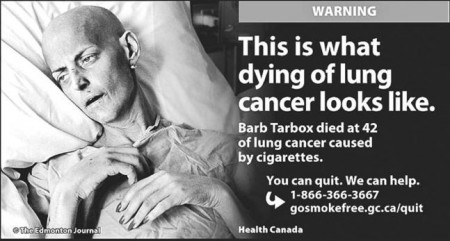Source: http://www.winnipegfreepress.com/
Sometimes it takes a good swift kick to open a person’s eyes. That’s the federal government’s strategy in its “scared straight” campaign urging Canadians to butt out by forcing tobacco companies to adorn their addictive products with gruesome images showing the consequences of smoking.
The graphic pictures include that of a human tongue rotting in the mouth of a person inflicted with mouth cancer. Other images portray cancer victims, literally human skeletons, at various stages of cancer with the Grim Reaper knocking at their back door.
Another shows a man with a hole in his neck — a victim of throat cancer — through which he now breathes. His message on the smoke pack: “I wish I had never started smoking.”
It’s a frank message that had to be brought home, and it’s apparently working. Statistics Canada reported this week smoking rates have dropped dramatically in the last 10 years, with steep declines in the number of teen smokers. Ottawa credits, in part, its mandatory, graphic anti-smoking packaging for tobacco products.
The new rules became official Tuesday. Tobacco companies must now label three-quarters of a cigarette package with grisly pictures showing the horrific consequences of smoking. The image of an emaciated, cancer-stricken Barb Tarbox, curled up in a fetal position in a hospital bed not long before her death, takes up three-quarters of some of the packages.
Tarbox became well-known as a powerful anti-smoking activist who, while inflicted with brain and lung cancers, gave numerous public appearances addressing younger people. The former model died in an Edmonton hospital in 2003, at the age of 42.
“This (graphic) initiative continues our efforts to inform Canadians — especially young people — about the hazards of smoking, said federal Health Minister Leona Aglukkaq.
Cigarette packages also display a national “quitline” and website addresses that smokers can access for help in kicking the addiction. It’s important to note nicotine is a for-real addiction, not a habit. It has been repeated countless times the addiction is more powerful than it is in the case of heroin.
Statistics Canada reported that not only are fewer people smoking, many who do are smoking less. Last year, one in five Canadians aged 12 and over — 5.8 million people — smoke on an occasional or a daily basis, down from 25.9 per cent in 2001. For teens aged 15 to 17, the rate fell over the same period to 9.4 per cent from 20.8 per cent. For those aged 18 to 19, the rate dropped to one in five from one in three. Not only that, but exposure to second-hand smoke has been halved.
Ottawa alone, however, can’t take full credit for the encouraging statistics. Increased education programs across the country, some beginning at the school-age level, and tough laws imposing harsh restrictions on when and where people can smoke, have contributed greatly to this downward trend.
Hopefully Ottawa’s “scared straight” initiative has a long-term effect, and more and more smokers will be butting out for good.
Source: Republished from the Winnipeg Free Press print edition June 22, 2012 A12


Leave A Comment
You must be logged in to post a comment.